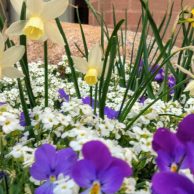 Boulder Valley Rose Society
Boulder Valley Rose Society
Hardy Roses Demonstration Garden
1770 13th St. Boulder, Colorado
This garden, planted in 1998, is both the Hardy Rose Demonstration Garden of the Boulder Valley Rose Society and an environment that delights the senses and calms the spirit, such as you might find at a teahouse in Tajikistan.
Designed by Eve Reshetnik-Brawner and Mikl Brawner, the garden includes 43 varieties of roses of many types, including Old Garden roses, Species roses, Canadian, Modern Shrub and David Austin’s English roses. These roses were chosen for their Old World Character, cold hardiness and disease-resistance. In addition, these roses are not grafted, but grown on their “own roots” which makes them tougher and longer-lived. These qualities have allowed the Boulder Valley Rose Society to maintain this rose garden without the use of chemical fertilizers, fungicides and pesticides. These roses are examples of how successful roses can be in Colorado.[Read More]

































 Welcome to Spring, to Harlequin’s Gardens and to another year of the challenges and joys of being alive on Earth, along with the opportunities, work, and healing rewards of gardening. It is both curious and common sense that as we nurture, we ourselves are nurtured.
Welcome to Spring, to Harlequin’s Gardens and to another year of the challenges and joys of being alive on Earth, along with the opportunities, work, and healing rewards of gardening. It is both curious and common sense that as we nurture, we ourselves are nurtured.












